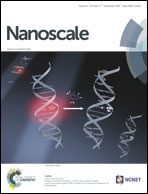Improved electronic coupling in hybrid organic–inorganic nanocomposites employing thiol-functionalized P3HT and bismuth sulfide nanocrystals†
Abstract
In this study, we employ a thiol-functionalized polymer (P3HT-SH) as a leverage to tailor the nanomorphology and electronic coupling in polymer–nanocrystal composites for hybrid solar cells. The presence of the thiol functional group allows for a highly crystalline semiconducting polymer film at low thiol content and allows for improved nanomorphologies in hybrid organic–inorganic systems when employing non-toxic bismuth sulfide nanocrystals. The exciton dissociation efficiency and carrier dynamics at this hybrid heterojunction are investigated through photoluminescence quenching and transient absorption spectroscopy measurements, revealing a larger degree of polaron formation when P3HT-SH is employed, suggesting an increased electronic interaction between the metal chalcogenide nanocrystals and the thiol-functionalized P3HT. The fabricated photovoltaic devices show 15% higher power conversion efficiencies as a result of the improved nanomorphology and better charge transfer mechanism together with the higher open circuit voltages arising from the deeper energy levels of P3HT-SH.


 Please wait while we load your content...
Please wait while we load your content...